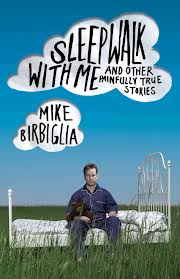First off, I want to say I’m not a beach person. Spending a week tanning is definitely not at the top of my ideal vacation activities. My lily-white Scandinavian has known a tan maybe once in my life (after a trip to Croatia) and even then it was a miracle considering all the sunscreen I lathered on. Lying on a towel fully exposed to the sun gods and with sand in my sensitive bits just seems not only boring but kinda irritating. Generally I prefer a bit of excitement in the form of hiking (see my Chilkoot Trail post) or the culture of a new city. However after spending a week on the Hawai’ian island Kauai, I’m beginning to rethink my stance on beaches. It could have been the excellent company (Philip plus two close friends and their toddler); it could have been my holiday reading, a book that made me want to ignore the aforementioned excellent company (and probably did on occasion – sorry guys!); or it could have been that the weather was just right: hot but not too hot, slightly humid, and a refreshing , constant breeze. Likely a combination of all of these factors made this a week that I wish could have been two.
 We stayed at the Kiahuna Plantation Resort in Poipu. The suites were condo-style and self-catering and for the most part I fully enjoyed staying there. (My reservations stem from an unbelievably irritating screen door that went off its hinges every. single. time. we tried to close it; as well as the lack of house-keeping the entire week we were there. Yeah, I know…first world problems.) We could see a sliver of ocean from our second-floor room and the sizeable balcony was an inviting place to eat breakfast. The beach was just a one-minute walk away.
We stayed at the Kiahuna Plantation Resort in Poipu. The suites were condo-style and self-catering and for the most part I fully enjoyed staying there. (My reservations stem from an unbelievably irritating screen door that went off its hinges every. single. time. we tried to close it; as well as the lack of house-keeping the entire week we were there. Yeah, I know…first world problems.) We could see a sliver of ocean from our second-floor room and the sizeable balcony was an inviting place to eat breakfast. The beach was just a one-minute walk away.
The week went something like this. Generally we lazed about in the morning, reading and relaxing. I’d generally have my nose in my guidebook, deciding how to spend the afternoon. (At this point I want to put in a plug for The Ultimate Kauai Guidebook from the folks at Hawaii Revealed. If you are going to Hawai’i, don’t bother getting any other guidebook. If the rest of the island guidebooks are anything like the Kauai edition, you will simultaneously be informed and entertained by the entries. It is detailed and full of interesting ideas of places to eat and things to see. And it feels like a good friend of yours wrote the reviews.) Ok, back to our week. We actually spent a few days not leaving the resort property. This surprised me because I’m usually desperate to get out and do something, generally not content to just sit around. But the beach was so damned close and the water was so warm and my book was just that good!
Despite the allure of the 3-minute walk to the beach, we did actually get out and see some of Kauai. The highlights:

 Waimea Canyon. Being 20 weeks pregnant at the time I wasn’t overly keen to do any kind of strenuous hiking in the Hawaiian heat, which was fine because it turns out neither did anyone else. (Apparently toddlers aren’t fantastic hiking companions anyway!) We drove up to the lip of the canyon to take in the view. Definitely not as impressive as the Grand Canyon but still…wow. If I hadn’t been feeling pretty pukey from the twisty car ride up, I would have enjoyed it more but I was quite taken by the grandeur of it. Picture a smaller, lusher, ocean-side version of the Grand Canyon, add some chickens in there (Kauai is overrun with chickens) and you’ll have Waimea Canyon. My pictures do not do it justice.
Waimea Canyon. Being 20 weeks pregnant at the time I wasn’t overly keen to do any kind of strenuous hiking in the Hawaiian heat, which was fine because it turns out neither did anyone else. (Apparently toddlers aren’t fantastic hiking companions anyway!) We drove up to the lip of the canyon to take in the view. Definitely not as impressive as the Grand Canyon but still…wow. If I hadn’t been feeling pretty pukey from the twisty car ride up, I would have enjoyed it more but I was quite taken by the grandeur of it. Picture a smaller, lusher, ocean-side version of the Grand Canyon, add some chickens in there (Kauai is overrun with chickens) and you’ll have Waimea Canyon. My pictures do not do it justice.
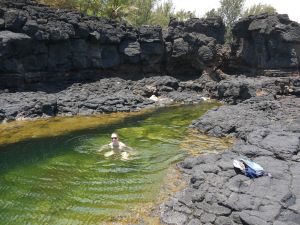

Secret Lava Pools. Not really all that secret given the sign that greeted us as we approached the treacherous, mud-laden trek down to the beach that read: “Don’t listen to guidebooks – many have died here this year at lavapools” Uh-huh. Nice try locals. The “secret” lavapools are reached by trekking down to ‘Secret Beach’, a wide expanse of beautiful sand with waves that make it way too rough to swim in, and then climbing over lava rocks for a few hundred yards. Being billed by my guidebook as one of the nicest places to take a dip in Kauai, I was pretty excited. So I was somewhat dismayed when we did finally reach the lavapools to find that the only swimmable one (IMHO) was only slightly bigger (albeit much deeper) than my bathtub at home. Philip had no desire to jump into an oversized puddle where he could not see the bottom (this from a guy who happily jumped one of the highest bungees in the world). We’d come that far and I was hot, sweaty, and pregnant, and I was going swimming, bathtub-sized puddle or not. So I got in. Admittedly I have had better bathing experiences. But it was still pretty cool to be in a lava pool and it was refreshing. Plus I was reasonably certain there were no sharks hiding nearby. I stayed in for a few minutes and then we went back to meet our friends who had stayed behind on Secret Beach.
 Kuilau Ridge Trail. To me this was absolute paradise. This hike was the essence of lush! Foliage draped the trail and there were flowers and birds everywhere. The scenery was spectacular. This was a simple out-and-back 2 mile hike with little elevation. Perfect. I thoroughly enjoyed listening to all the unfamiliar bird songs. If the beach hadn’t anxiously been waiting for us (and if we’d brought some food along) we would have stayed all day.
Kuilau Ridge Trail. To me this was absolute paradise. This hike was the essence of lush! Foliage draped the trail and there were flowers and birds everywhere. The scenery was spectacular. This was a simple out-and-back 2 mile hike with little elevation. Perfect. I thoroughly enjoyed listening to all the unfamiliar bird songs. If the beach hadn’t anxiously been waiting for us (and if we’d brought some food along) we would have stayed all day.
 The Beaches of Maha’ulepu. There are three beaches just to the east of Poipu that sport some pretty fascinating geology. This is rugged, harsh Kauai where the sea has attacked the limestone ridges to form
The Beaches of Maha’ulepu. There are three beaches just to the east of Poipu that sport some pretty fascinating geology. This is rugged, harsh Kauai where the sea has attacked the limestone ridges to form
 lithified cliffs. Even though these beaches were just a 10 minute drive from our hotel, it felt like we were on a completely different island. The water was still a gorgeous aqua blue but the waves were roaring and crashing against the shoreline, making for a less-than-inviting swim. The seaside was barren – no trees along the immediate coast – so it felt more like Newfoundland than Hawai’i. Investigating the effects of erosion and rough seas was absorbing and I thoroughly enjoyed this excursion.
lithified cliffs. Even though these beaches were just a 10 minute drive from our hotel, it felt like we were on a completely different island. The water was still a gorgeous aqua blue but the waves were roaring and crashing against the shoreline, making for a less-than-inviting swim. The seaside was barren – no trees along the immediate coast – so it felt more like Newfoundland than Hawai’i. Investigating the effects of erosion and rough seas was absorbing and I thoroughly enjoyed this excursion.
 Shave Ice. I’m not sure if this delight is unique to Hawaii but it is a delicious one! I had seen signs for shave ice all over Kauai but wasn’t too excited about trying it, thinking it must be like a snow cone. When we finally went to Jo-Jo’s Clubhouse, which apparently has the best shave ice on the island, we discovered that shave ice is like a snow cone the way fettucini alfredo served in Florence is like Kraft dinner. The basic ingredients are the same – pasta, cheese, “cheese” – but they are vastly different things. Unlike a snow cone which is made with crushed ice, snow cones are made by shaving a block of ice with a sharp knife, then adding two or three (or more) rich flavours and a scoop of ice cream. I had one of Jo-Jo’s specials, pina colada, which had pineapple, coconut, and strawberry along with coconut cream and a scoop of macadamia nut ice cream. Heaven. The picture below is of shave ice from a lesser establishment as I failed to capture the Jo-Jo’s magic in photo form. But you get the idea.
Shave Ice. I’m not sure if this delight is unique to Hawaii but it is a delicious one! I had seen signs for shave ice all over Kauai but wasn’t too excited about trying it, thinking it must be like a snow cone. When we finally went to Jo-Jo’s Clubhouse, which apparently has the best shave ice on the island, we discovered that shave ice is like a snow cone the way fettucini alfredo served in Florence is like Kraft dinner. The basic ingredients are the same – pasta, cheese, “cheese” – but they are vastly different things. Unlike a snow cone which is made with crushed ice, snow cones are made by shaving a block of ice with a sharp knife, then adding two or three (or more) rich flavours and a scoop of ice cream. I had one of Jo-Jo’s specials, pina colada, which had pineapple, coconut, and strawberry along with coconut cream and a scoop of macadamia nut ice cream. Heaven. The picture below is of shave ice from a lesser establishment as I failed to capture the Jo-Jo’s magic in photo form. But you get the idea.
One regret from the week? Not getting a photo of the positively ENORMOUS spider that did the 100m Olympic sprint à la Usain Bolt across the living room as we sat chatting. Never has my heart leapt into my throat at the sight of a spider. I am no fan of spiders but I usually silently tolerate them, unless they are the size of a dinner plate, in which case I shriek, pointing slack-jawed at the offender, in the hopes that someone of the male persuasion will do something about it. In this case Philip and our friend Sean did battle for us women. Weapon of choice? A heavy red binder. There was no way this thing was going to be coaxed into a jar, a piece of cardboard slid gently under the opening. After a quick search I determined that the beast was a cane spider: harmless as it turns out but seriously scary. The reason I wish I had photo evidence is that I find it remarkable how distinctly different our recollections are of the size of the spider. Us women, we agree it was about the size of my face. Philip and Sean? The size of my palm. Is this a male-female phenomenon? I want photo evidence.
 In my third year of my undergraduate degree in French, I thought it would be interesting to take a class in Quebec literature. I had taken a lot of ‘classic’ French lit courses up until that point, covering such works as Madame Bovary and Germinal and I figured it was time I connected with Canadian francophone writers. It was in this class that I decided that with few exceptions, Canadian literature (both anglophone and francophone) is boring. I had had my suspicions before taking the Quebec lit course, having struggled through a few dull Margaret Laurence and Margaret Atwood novels. But it wasn’t until the Quebec literature class that it dawned on me: Canadians are boring! Case in point: the first book we read in class was called Le Survenant, about a family that owns a farm and one day a stranger shows up to help. Quite seriously, nothing else happens and there are some mind-numbing pages describing farm chores. I still remember actually being angry at the book for being so utterly dull, and this was more than ten years ago! I have since been hesitant to pick up novels by Canadian writers and will only do so on the strong recommendation of friends.
In my third year of my undergraduate degree in French, I thought it would be interesting to take a class in Quebec literature. I had taken a lot of ‘classic’ French lit courses up until that point, covering such works as Madame Bovary and Germinal and I figured it was time I connected with Canadian francophone writers. It was in this class that I decided that with few exceptions, Canadian literature (both anglophone and francophone) is boring. I had had my suspicions before taking the Quebec lit course, having struggled through a few dull Margaret Laurence and Margaret Atwood novels. But it wasn’t until the Quebec literature class that it dawned on me: Canadians are boring! Case in point: the first book we read in class was called Le Survenant, about a family that owns a farm and one day a stranger shows up to help. Quite seriously, nothing else happens and there are some mind-numbing pages describing farm chores. I still remember actually being angry at the book for being so utterly dull, and this was more than ten years ago! I have since been hesitant to pick up novels by Canadian writers and will only do so on the strong recommendation of friends.


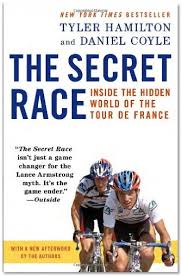

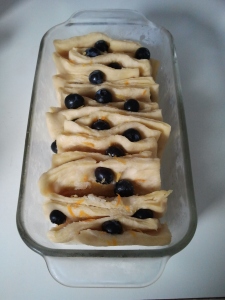
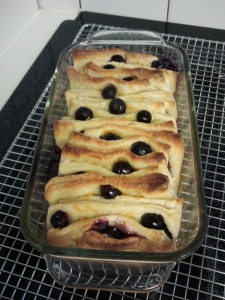









 lithified cliffs. Even though these beaches were just a 10 minute drive from our hotel, it felt like we were on a completely different island. The water was still a gorgeous aqua blue but the waves were roaring and crashing against the shoreline, making for a less-than-inviting swim. The seaside was barren – no trees along the immediate coast – so it felt more like Newfoundland than Hawai’i. Investigating the effects of erosion and rough seas was absorbing and I thoroughly enjoyed this excursion.
lithified cliffs. Even though these beaches were just a 10 minute drive from our hotel, it felt like we were on a completely different island. The water was still a gorgeous aqua blue but the waves were roaring and crashing against the shoreline, making for a less-than-inviting swim. The seaside was barren – no trees along the immediate coast – so it felt more like Newfoundland than Hawai’i. Investigating the effects of erosion and rough seas was absorbing and I thoroughly enjoyed this excursion.


